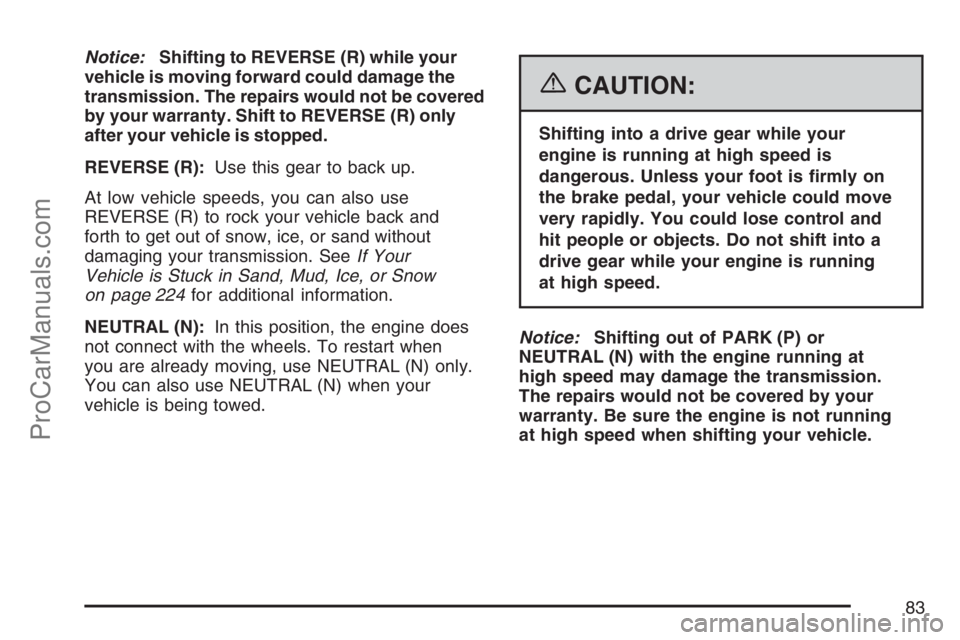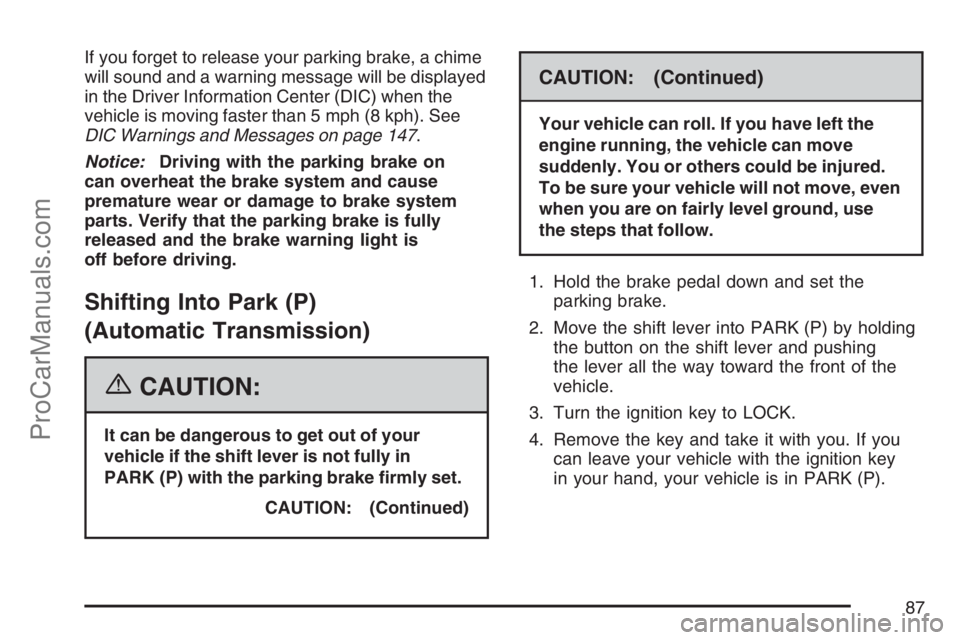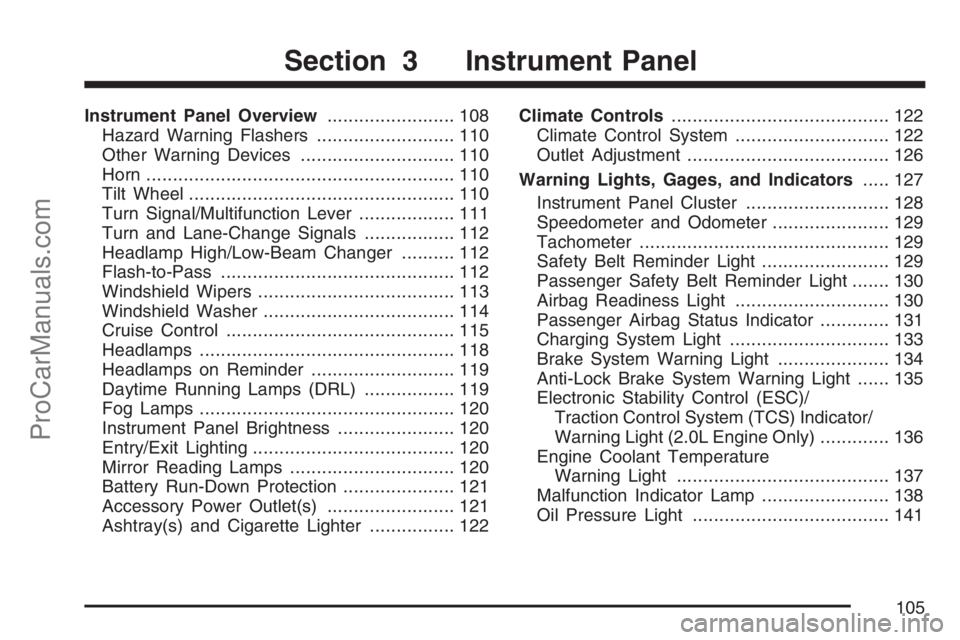engine SATURN SKY 2007 User Guide
[x] Cancel search | Manufacturer: SATURN, Model Year: 2007, Model line: SKY, Model: SATURN SKY 2007Pages: 384, PDF Size: 2.47 MB
Page 82 of 384

Automatic Transmission Operation
If your vehicle has an automatic transmission,
the shift lever is located on the center console
between the front seats.
There are several
different positions for
the shift lever.
PARK (P):This position locks the rear wheels.
It is the best position to use when you start the
engine because your vehicle cannot move easily.{CAUTION:
It can be dangerous to get out of your
vehicle if the shift lever is not fully in
PARK (P) with the parking brake �rmly
set. Your vehicle can roll. If you have left
the engine running, the vehicle can move
suddenly. You or others could be injured.
To be sure your vehicle will not move,
even when you are on fairly level ground,
use the steps that follow.
Make sure the shift lever is fully in PARK (P)
before starting the engine. Your vehicle has an
automatic transmission shift lock control system.
You must fully apply your regular brakes �rst
and then press the shift lever button before you
can shift from PARK (P) when the ignition key is
in RUN. If you cannot shift out of PARK (P),
ease pressure on the shift lever and push the
shift lever all the way into PARK (P) as you
maintain brake application. Then press the shift
lever button and move the shift lever into another
gear. SeeShifting Out of Park (P) on page 89.
82
ProCarManuals.com
Page 83 of 384

Notice:Shifting to REVERSE (R) while your
vehicle is moving forward could damage the
transmission. The repairs would not be covered
by your warranty. Shift to REVERSE (R) only
after your vehicle is stopped.
REVERSE (R):Use this gear to back up.
At low vehicle speeds, you can also use
REVERSE (R) to rock your vehicle back and
forth to get out of snow, ice, or sand without
damaging your transmission. SeeIf Your
Vehicle is Stuck in Sand, Mud, Ice, or Snow
on page 224for additional information.
NEUTRAL (N):In this position, the engine does
not connect with the wheels. To restart when
you are already moving, use NEUTRAL (N) only.
You can also use NEUTRAL (N) when your
vehicle is being towed.
{CAUTION:
Shifting into a drive gear while your
engine is running at high speed is
dangerous. Unless your foot is �rmly on
the brake pedal, your vehicle could move
very rapidly. You could lose control and
hit people or objects. Do not shift into a
drive gear while your engine is running
at high speed.
Notice:Shifting out of PARK (P) or
NEUTRAL (N) with the engine running at
high speed may damage the transmission.
The repairs would not be covered by your
warranty. Be sure the engine is not running
at high speed when shifting your vehicle.
83
ProCarManuals.com
Page 85 of 384

Manual Transmission Operation
This is the shift pattern
for a manual
transmission.
Here is how to operate your manual transmission:
FIRST (1):Press the clutch pedal and shift into
FIRST (1). Then, slowly let up on the clutch pedal
as you press the accelerator pedal.
You can shift into FIRST (1) when you are going
less than 20 mph (32 km/h). If you have come to a
complete stop and it is hard to shift into FIRST (1),
put the shift lever in NEUTRAL and let up on
the clutch pedal. Press the clutch pedal back
down. Then shift into FIRST (1).SECOND (2):Press the clutch pedal as you let
up on the accelerator pedal and shift into
SECOND (2). Then, slowly let up on the clutch
pedal as you press the accelerator pedal.
THIRD (3), FOURTH (4) and FIFTH (5):Shift into
THIRD (3), FOURTH (4) and FIFTH (5) the
same way you do for SECOND (2).
To stop, let up on the accelerator pedal and press
the brake pedal. Just before the vehicle stops,
press the clutch pedal and the brake pedal,
and shift to NEUTRAL.
NEUTRAL:Use this position when you start or
idle your engine.
85
ProCarManuals.com
Page 87 of 384

If you forget to release your parking brake, a chime
will sound and a warning message will be displayed
in the Driver Information Center (DIC) when the
vehicle is moving faster than 5 mph (8 kph). See
DIC Warnings and Messages on page 147.
Notice:Driving with the parking brake on
can overheat the brake system and cause
premature wear or damage to brake system
parts. Verify that the parking brake is fully
released and the brake warning light is
off before driving.
Shifting Into Park (P)
(Automatic Transmission)
{CAUTION:
It can be dangerous to get out of your
vehicle if the shift lever is not fully in
PARK (P) with the parking brake �rmly set.
CAUTION: (Continued)
CAUTION: (Continued)
Your vehicle can roll. If you have left the
engine running, the vehicle can move
suddenly. You or others could be injured.
To be sure your vehicle will not move, even
when you are on fairly level ground, use
the steps that follow.
1. Hold the brake pedal down and set the
parking brake.
2. Move the shift lever into PARK (P) by holding
the button on the shift lever and pushing
the lever all the way toward the front of the
vehicle.
3. Turn the ignition key to LOCK.
4. Remove the key and take it with you. If you
can leave your vehicle with the ignition key
in your hand, your vehicle is in PARK (P).
87
ProCarManuals.com
Page 88 of 384

Leaving Your Vehicle With the
Engine Running
{CAUTION:
It can be dangerous to leave your vehicle
with the engine running. Your vehicle
could move suddenly if the shift lever is
not fully in PARK (P) with the parking
brake �rmly set. And, if you leave the
vehicle with the engine running, it could
overheat and even catch �re. You or
others could be injured. Do not leave your
vehicle with the engine running.
If you have to leave your vehicle with the engine
running, be sure your vehicle is in PARK (P)
and your parking brake is �rmly set before you
leave it. After you have moved the shift lever into
PARK (P), hold the regular brake pedal down.If the vehicle has an automatic transmission, see if
you can move the shift lever away from PARK (P)
without �rst pushing the shift lock release button.
If you can, it means that the shift lever was not fully
locked into PARK (P).Torque Lock
If you are parking on a hill and you do not
shift your transmission into PARK (P) properly,
the weight of the vehicle may put too much
force on the parking pawl in the transmission.
You may �nd it difficult to pull the shift lever
out of PARK (P). This is called “torque lock.”
To prevent torque lock, set the parking brake
and then shift into PARK (P) properly before you
leave the driver’s seat. To �nd out how, see
Shifting Into Park (P) (Automatic Transmission)
on page 87.
88
ProCarManuals.com
Page 91 of 384

Engine Exhaust
{CAUTION:
Engine exhaust can kill. It contains the
gas carbon monoxide (CO), which you
cannot see or smell. It can cause
unconsciousness and death.
You might have exhaust coming in if:
Your exhaust system sounds strange
or different.
Your vehicle gets rusty underneath.
Your vehicle was damaged in a
collision.
CAUTION: (Continued)
CAUTION: (Continued)
Your vehicle was damaged when
driving over high points on the
road or over road debris.
Repairs were not done correctly.
Your vehicle or exhaust system has
been modi�ed improperly.
If you ever suspect exhaust is coming
into your vehicle:
Drive it only with all the windows
down to blow out any CO; and
Have your vehicle �xed immediately.
91
ProCarManuals.com
Page 92 of 384

Running the Engine While Parked
It is better not to park with the engine running. But if
you ever have to, here are some things to know.
{CAUTION:
Idling the engine with the climate control
system off could allow dangerous exhaust
into your vehicle. See the earlier caution
underEngine Exhaust on page 91.
Also, idling in a closed-in place can let
deadly carbon monoxide (CO) into your
vehicle even if the climate control fan is
at the highest setting. One place this
can happen is a garage. Exhaust — with
CO — can come in easily. NEVER park
in a garage with the engine running.
Another closed-in place can be a blizzard.
SeeWinter Driving on page 218.
{CAUTION:
It can be dangerous to get out of your
vehicle if the automatic transmission shift
lever is not fully in PARK (P) with the
parking brake �rmly set. Your vehicle can
roll. Do not leave your vehicle when the
engine is running unless you have to.
If you have left the engine running, the
vehicle can move suddenly. You or others
could be injured. To be sure your vehicle
will not move, even when it is on fairly
level ground, always set the parking brake
and move the automatic transmission
shift lever to PARK (P), or the manual
transmission shift lever to NEUTRAL.
Follow the proper steps to be sure your vehicle
will not move. SeeShifting Into Park (P)
(Automatic Transmission) on page 87andParking
Your Vehicle (Manual Transmission) on page 89.
92
ProCarManuals.com
Page 105 of 384

Instrument Panel Overview........................ 108
Hazard Warning Flashers.......................... 110
Other Warning Devices............................. 110
Horn.......................................................... 110
Tilt Wheel.................................................. 110
Turn Signal/Multifunction Lever.................. 111
Turn and Lane-Change Signals................. 112
Headlamp High/Low-Beam Changer.......... 112
Flash-to-Pass............................................ 112
Windshield Wipers..................................... 113
Windshield Washer.................................... 114
Cruise Control........................................... 115
Headlamps................................................ 118
Headlamps on Reminder........................... 119
Daytime Running Lamps (DRL)................. 119
Fog Lamps................................................ 120
Instrument Panel Brightness...................... 120
Entry/Exit Lighting...................................... 120
Mirror Reading Lamps............................... 120
Battery Run-Down Protection..................... 121
Accessory Power Outlet(s)........................ 121
Ashtray(s) and Cigarette Lighter................ 122Climate Controls......................................... 122
Climate Control System............................. 122
Outlet Adjustment...................................... 126
Warning Lights, Gages, and Indicators..... 127
Instrument Panel Cluster........................... 128
Speedometer and Odometer...................... 129
Tachometer............................................... 129
Safety Belt Reminder Light........................ 129
Passenger Safety Belt Reminder Light....... 130
Airbag Readiness Light............................. 130
Passenger Airbag Status Indicator............. 131
Charging System Light.............................. 133
Brake System Warning Light..................... 134
Anti-Lock Brake System Warning Light...... 135
Electronic Stability Control (ESC)/
Traction Control System (TCS) Indicator/
Warning Light (2.0L Engine Only)............. 136
Engine Coolant Temperature
Warning Light........................................ 137
Malfunction Indicator Lamp........................ 138
Oil Pressure Light..................................... 141
Section 3 Instrument Panel
105
ProCarManuals.com
Page 123 of 384

#(Air Conditioning):Press the left knob on
the control panel to turn the air conditioning system
on or off. An indicator light on the button will
come on to let you know the air conditioning is
activated. When the system is on, this setting cools
and dehumidi�es the air entering your vehicle.
The air conditioning will not function if the fan is
turned off. If air conditioning is selected with
fan off, the indicator light �ashes three times and
then turns off.
There could be a slight change in engine
performance when the air conditioning compressor
turns off and turns on again. This is normal. The
system is designed to make adjustments to
help with fuel economy while still maintaining the
selected temperature.
The air conditioning system removes moisture
from the air, so a small amount of water can drip
underneath your vehicle while idling or after
turning off the engine. This is normal.Air conditioning does not operate at temperature
below 40°F (4°C). In temperatures above 40°F
(4°C), the air conditioning cannot be turned off in
defrost, �oor/defog, and recirculation modes
because it helps to remove moisture from the
vehicle. It also helps to keep the windows clear.
On hot days, open the windows to let the hot
inside air escape; then close them. This helps
reduce the time it takes for the vehicle to
cool down. It also helps the system to operate
more efficiently.
For quick cool down on hot days, do the following:
1. Select the vent mode.
2. Select recirculation mode.
3. Select the air conditioning to on.
4. Select the coolest temperature.
5. Select the highest fan speed.
Using these settings together for long periods of
time can cause the air inside of the vehicle to
become too dry. To prevent this from happening,
after the air in the vehicle has cooled, turn the
recirculation mode off.
123
ProCarManuals.com
Page 125 of 384

Defogging and Defrosting
Fog on the inside of windows is a result of
high humidity (moisture) condensing on the
cool window glass. This can be minimized if the
climate control system is used properly. There
are two modes to clear fog or frost from your
windshield and side windows. Use the defog
mode to clear the windows of fog or moisture and
warm the passengers. Use the defrost mode to
remove fog or frost from the windshield more
quickly. For best results, clear all snow and ice
from the windshield before defrosting. Use a
temperature setting that provides warm air. The
warmer the air the quicker the windows clear.
To prevent fogging on the inside of the windows
in modes other than �oor/defog and defrost,
make sure the air conditioning compressor is on
and recirculation mode is off.
/(Floor/Defog):Turn the right knob on the
control panel to this mode to direct the air to the
windshield, the side window outlets, and to the �oor
outlets. When you select this mode, the system
runs the air conditioning compressor unless the
outside temperature is near freezing or below.
0(Defrost):Turn the right knob on the control
panel to this mode to direct most of the air to
the windshield, and the side window outlets.
When you select this mode, the system runs the
air conditioning compressor unless the outside
temperature is near or below freezing.
Do not drive the vehicle until all the windows
are clear.
Rear Window Defogger
The rear window defogger uses a warming grid
to remove fog or frost from the rear window. Be
sure to clear as much snow from the rear window
as possible. An indicator light on the knob comes
on while the rear window defogger is activated.
The rear window defogger will turn off about
�fteen minutes after the knob is pressed. If turned
on again, the defogger will run for about seven and
one-half minutes before turning off. If vehicle
speed is greater than 50 mph (80 kph) and the
rear defogger is active, it will remain on as long
as the speed is greater than 50 mph (80 kph).
The defogger can also be turned off by pressing
the knob again or by turning off the engine.
125
ProCarManuals.com